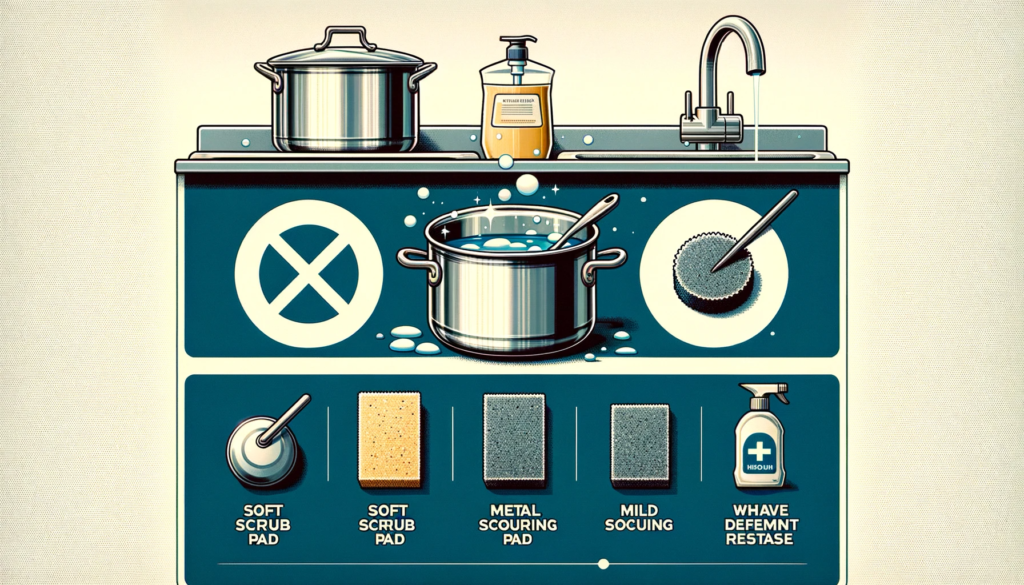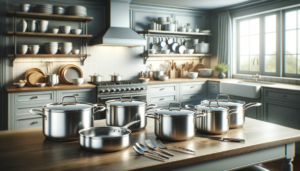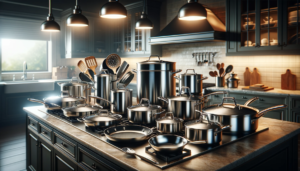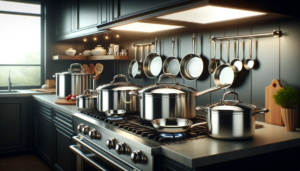With iconic gleaming finishes gracing many kitchens, stainless steel offers the convenience of going seamlessly from stovetop to oven to table.
But can just any stainless steel pan handle the consistent, extreme heat of a gas stove?
Understanding stainless steel compositions and matching performance characteristics to cooking demands delivers safe, long-lasting gas range versatility.
Let’s examine what makes stainless steel excel on gas stoves from durability to heat conduction and how to choose cookware extending quality and enjoyment.
Can Stainless Steel Go on a Gas Stove?

Yes, stainless steel pots and pans are well-suited for gas stove cooking.
When using appropriate grades of stainless steel designed for cookware such as 304 or 316, stainless steel conducts heat quickly and evenly.
It also withstands the rapid heating and cooling cycles of gas burners.
Stainless steel resists warping, denting, corrosion, and retains its smooth, durable finish despite repetitive high heat exposure.
Below we explore specifics about stainless steel composition, cookware considerations, proper use and care for optimal gas stove versatility and longevity.
But in short – quality stainless steel excels on gas ranges meeting all home chef demands.
Defining Stainless Steel

Stainless steel gets its name from its resistance to stains, rust, and corrosion.
Unlike carbon steel, stainless steel contains chromium which forms an invisible passive layer of chromium oxide when exposed to oxygen.
This protective layer shields against oxidation keeping the surface smooth and shiny.
Varying the amounts of chromium and other metals like nickel, molybdenum, titanium, copper, carbon, and nitrogen creates different grades with unique properties.
Other key traits include durability, low maintenance, strength, and aesthetic appeal.
Grades of Stainless Steel Used in Cookware

The most common grades of stainless steel used for pots, pans, kettles, and other cookware include:
Grade 304
Contains a minimum of 18% chromium and 8% nickel (often more).
Grade 304, also labeled 18/8, has excellent corrosion resistance suitable for dishwashers, sinks, and a wide range of home and commercial applications.
It also resists a variety of foods and solutions making it ideal for kitchenware.
Grade 316
Similar to grade 304 but contains 2-3% molybdenum along with more nickel increasing cost.
The nickel and molybdenum enhance protection against salt exposure, some acids, and overall pitting and corrosion.
This makes grade 316 a good choice for cooking salty or acidic foods.
Grade 430
Less expensive grade 430 has less nickel than 304 and no molybdenum content.
It satisfies general demands but is more prone to corrosion and pitting with repeated heating and washing.
Requires extra care especially when cooking acidic ingredients.
Overall grade 304 offers the best balance of corrosion resistance, durability, and cost for most stainless steel cookware needs.
Grade 316 provides added protection when cooking foods with high salt or acid content.
Key Benefits of Cooking with Stainless Steel

Understanding why stainless steel works well on gas stoves relies partly on appreciating key benefits compared to alternatives like copper or ceramic.
Quick, Even Heating
Stainless steel construction spreads heat quickly and evenly across the entire surface – bottom and sides – unlike slower-heating ceramic or potentially uneven copper.
This allows stainless steel to respond rapidly to changes in temperature from the gas range burners.
Good Heat Retention
While stainless steel cookware does not retain maximum heat like some options, the properties allow it to hold in enough warmth and energy to finish off the cooking process with the burner turned down or off.
Heavier gauges of steel improve heat retention further.
Resists Dents, Scratches, and Warping
Quality stainless steel shows high resistance to surface damage from metal cooking utensils.
It also retains the original shape well through rapid heating and cooling cycles from the stove to oven to table.
This durability comes in part from the protective chromium layer.
Lower Maintenance
Stainless steel maintains its clean, smooth look with simple washing by hand.
Its hardy properties limit the need for special salts or cleaning solutions required by other surfaces.
Simply using soft scrub pads and mild soap after each use avoids residue build up.
By understanding key upsides like durability, heat conductivity, visual appeal, and easy care stainless steel clearly performs well on gas ranges.
Proper Care Guidelines

While stainless steel shows excellent corrosion and scratch resistance, best practices for care and cleaning preserve appearance and cooking functionality over many years.
Consider several tips:
- Don’t leave empty stainless steel pans on high gas heat.
Overheating damages protective layers inviting deterioration and warping over time. - Allow foods to heat gradually after adding to hot pans.
Searing meats before liquids prevent sticking.
Consider oil for very lean items. - Wash stainless steel pans by hand with non-abrasive pads.
Dishwasher detergents combined with hot, pressurized water speeds surface breakdown. - Avoid metal scouring pads and oven cleaners which negatively react with stainless steel finishes.
- Rinse detergent completely after washing as residue builds up reducing shine.
- Apply a thin external food-safe polish to restore original brilliant, mirrored finishes if desired over time.
Following these simple stainless steel cookware care guidelines keeps gas range pans looking great and cooking evenly for years of enjoyment.
Shopping for High Quality Stainless Steel
When evaluating stainless steel cookware options for gas stove cooking, consider several key factors:
Durable, Tight-Fitting Lids
Snug-fitting lids trap heat, moisture and food aromas effectively.
Glass tops allow monitoring food without releasing steam.
Durable stainless steel lids withstand high oven temps.
Secure, Stay-Cool Handles
Look for steel or cast iron handles tightly riveted providing a safe, solid grip when moving hot pans.
Contoured handles with non-heat conducting cores prevent burns.
Optimal Weight and Base Thickness
Heavier-gauge steel protects better and cooks more evenly but lightness offers cooking control.
Balanced gauge with metal core bases for good conductivity and durability suit most kitchens.
Helper Handles & Pour Spouts
Pots and pans over 8 inches and filled pots benefit from helper handles for safe lifting.
Pour spouts allow strain-free, dripless emptying for ease of use.
Evaluating options using criteria like durability, safety and performance helps identify quality stainless steel cookware that excels at gas stove cooking for maximum enjoyment.
Conclusion
From understanding stainless steel compositions to buying the best cookware for gas stoves, making informed choices positions a kitchen for safe, high-performing longevity.
Stainless steel grades 304 and 316 stand as go-to choices for their corrosion resistance, durability to dings and warping, fast-even heating properties and temperature retention.
Matching high-quality stainless steel pots and pans having evenly heating bases and secure lids and handles completes the package for easily handling simmering, searing, braising and more culinary endeavors.
By selecting suitable stainless steel gas stove cookware, home chefs gain versatility across dishes achieving reliable, uniform results for countless breakfasts, lunches and dinners for years on end.



